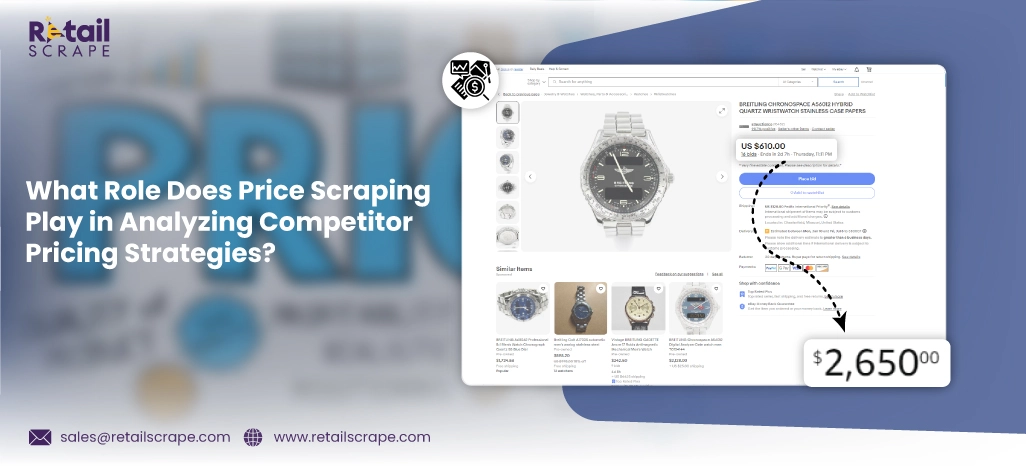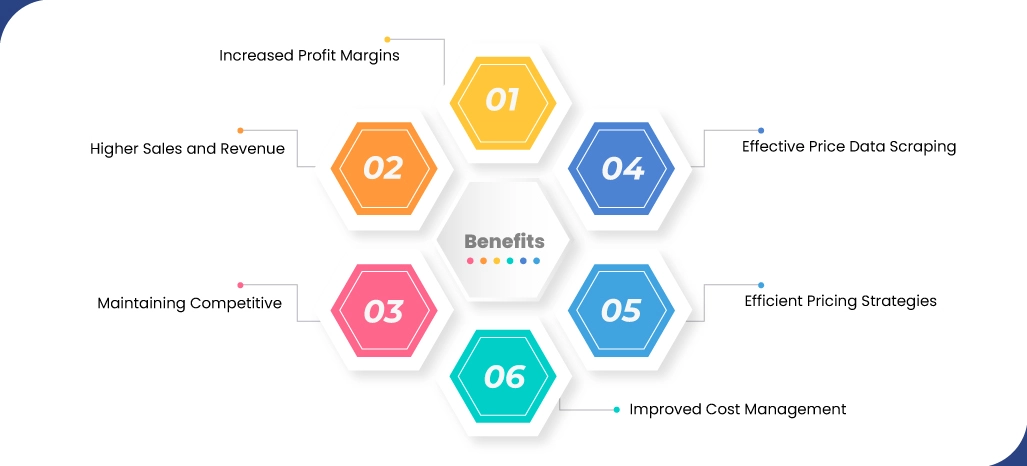
Setting the right price for a product or service is critical for a manufacturer's success, as it impacts profitability and customer acquisition. Overpricing can deter potential customers while underpricing can harm revenue. Competitive pricing, a common strategy, involves analyzing competitors' prices to set your own. This approach can help differentiate your brand and protect market share.
Price determination requires research and effort. Scrape price data from various sources, especially eCommerce sites, to monitor competitors' prices and make informed pricing decisions. Price scraping involves using web scrapers to gather prices of products and services from online sources, with or without permission. It is commonly used by businesses, such as travel, retail, and eCommerce, to implement dynamic pricing models.
Thus, leveraging price data scraping services can aid in effective pricing strategies, ensuring competitiveness and profitability. However, it's crucial to conduct this practice ethically and comply with legal guidelines to maintain trust and integrity in the market.
Understanding Competitive Pricing Analysis
Competitive pricing analysis is a strategic process retailers use to evaluate and adjust their pricing strategies based on their competitors' pricing data. By gathering and analyzing market data, retailers can determine how their prices compare to competitors and make informed decisions to attract more customers.
This technique involves continuously monitoring competitors' prices and product offerings. Retailers use this data to optimize their prices, ensuring they remain competitive. Through competitive pricing analysis, retailers can predict and respond to systematic price changes, ultimately increasing their customer base and revenue.
One key advantage of competitive pricing analysis is the ability to scrape price data from various online sources. Hence, it allows retailers to monitor their competitors in real-time and make timely adjustments to their pricing strategies. By analyzing this data, retailers can identify trends, understand market dynamics, and develop pricing strategies that are more responsive to customer demands.
Overall, competitive pricing analysis is essential for retailers looking to improve their market position and drive profitability. By leveraging price data scrapers and other analytical techniques, retailers can stay ahead of the competition and meet their customers' evolving needs.
Benefits of Competitor Pricing Analysis for Retailers

Competitor pricing analysis offers several advantages to retailers, enabling them to enhance their pricing strategies and overall business performance:
Increased Profit Margins: By adjusting product and service prices based on competitor analysis, retailers can maximize their profit margins by ensuring competitive yet profitable prices.
Higher Sales and Revenue: Optimizing prices based on competitor data can attract more customers, increasing retailers' sales and revenue.
Maintaining Competitive Position: Regular analysis helps retailers stay competitive by adjusting prices to match or beat competitors.
Improved Cost Management: By comparing prices with competitors, retailers can negotiate better with suppliers and manage overhead and manufacturing costs more effectively.
Efficient Pricing Strategies: Analysis of competitor pricing data enables retailers to develop efficient pricing strategies, especially during critical periods like season-end sales or holidays.
Effective Price Data Scraping: Using an e-commerce price data scraping tool allows retailers to gather competitor pricing data efficiently, providing valuable insights for pricing decisions without complex coding.
Understanding Price Scraping Tools
Price scraping tools, also known as price scrapers, are software applications or bots designed to extract pricing information from various websites. This technique involves deploying bots to collect pricing data from targeted websites, allowing businesses to analyze and compare prices with competitors. Price scraping tools can automate this process, providing up-to-date pricing information and enabling businesses to adjust their pricing strategies accordingly.
One key advantage of price scraping tools is their ability to gather data without complex coding. Users can input the URLs of the websites they wish to scrape, and the tool will extract the relevant pricing information in a well-formatted file. It makes monitoring and analyzing competitor pricing strategies easier for businesses, especially eCommerce stores.
For example, a price scraping tool can help an eCommerce store track prices on platforms like Amazon or eBay, allowing them to adjust their prices competitively. These tools can scrape price-related data regularly, such as hourly, daily, or weekly, providing businesses with timely insights to make informed pricing decisions.
Overall, price scraping tools are crucial in helping businesses gather and analyze pricing information from competitors, ultimately enabling them to stay competitive in the market.
Price Scraping in the eCommerce Sector
eCommerce has revolutionized global markets, disrupting traditional retail models even before the onset of the COVID-19 pandemic. However, competition has intensified with the proliferation of online sellers offering similar products. Whether it's clothing, supplements, shoes, accessories, sportswear, cosmetics, or any other product category, success in eCommerce hinges on understanding market dynamics, particularly pricing strategies. Pricing intelligence is crucial for eCommerce businesses seeking a competitive edge. It involves gathering and analyzing price data from various sources to make informed pricing decisions. By understanding competitors' pricing strategies and market trends, businesses can optimize their pricing to maximize sales and profitability.
To gather pricing data, businesses can use APIs provided by platforms like Amazon. These APIs allow for the extraction of price data in a structured manner, enabling businesses to integrate this data seamlessly into their own apps or software. This data can include current prices, historical price trends, and competitor pricing information.
Once the pricing data is extracted, the next step is price matching. Due to slight variations in product details across eCommerce portals, implementing a robust matching system is essential. This system ensures that pricing decisions are based on accurate and up-to-date information, enabling businesses to automate the pricing process and stay competitive.
Why Businesses Must Embrace Price Scraping: Leveraging Competitive Intelligence for Success

In the dynamic landscape of eCommerce, pricing plays a pivotal role in influencing consumer behavior and ultimately driving sales. The decision-making process behind pricing a product or service involves production costs, market demand, and competitor pricing strategies. In this context, the importance of competitor price analysis cannot be overstated, as it provides valuable insights that can inform pricing decisions and enhance competitiveness.
Easy Price Tracking and Discovery of Bargains
Consumers are inherently price-sensitive and often seek bargains when making purchasing decisions. By leveraging price data scraping tools, businesses can track price sensitivity, assess competitors' pricing strategies, and identify opportunities to adjust their pricing to stay competitive. This real-time data enables businesses to offer products at optimal prices, attracting value-conscious consumers and maximizing profitability.
Real-time Competitor Analysis
In today's digital age, staying competitive requires real-time insights into market trends and competitor pricing strategies. Price scraping allows businesses to gather and analyze data from competitors' websites, providing a comprehensive view of market values and pricing dynamics. This information is invaluable for businesses looking to enhance their competitiveness and capture a larger market share.
Proactive Strategy Development
Effective business strategies are built on thorough research and data analysis. Price scraping gives businesses access to large-scale data sets, allowing them to identify trends, consumer preferences, and market demands. With this information, businesses can develop proactive strategies that anticipate market needs and position them for long-term success.
Analytics and Forecasting
Data analytics is crucial in understanding consumer behavior and predicting future trends. By scraping price data and analyzing consumer shopping habits, businesses can gain valuable insights into customer preferences, demand trends, and pricing sensitivities. This data-driven approach enables businesses to tailor their offerings to meet customer needs, driving sales and profitability.
Personalized Offers
Personalization has become a key differentiator for businesses looking to enhance customer experiences and drive loyalty. Price scraping allows businesses to gather data on customer segments and tailor their offerings accordingly. Businesses can attract and retain customers by offering personalized product offers and discounts, ultimately increasing sales and profitability.
Consumer Behavior Analysis
Understanding consumer behavior is critical for businesses looking to optimize their operations and maximize profitability. Price scraping enables businesses to gather data on consumer purchasing habits, preferences, and price sensitivities. This data can be used to adjust pricing strategies, product offerings, and marketing campaigns to align with consumer preferences and drive sales.
Is Price Scraping Legal? Understanding the Boundaries of Web Data Collection
Scraping or crawling the web is legal, as it's not explicitly prohibited. However, there are nuances to consider, especially regarding personal data and data privacy laws. While scraping public data for business insights or research is generally acceptable, scraping personal information may violate data protection regulations like the General Data Protection Regulation (GDPR) in the EU or the California Consumer Privacy Act (CCPA) in the USA.
To ensure legality, it's essential to comply with local regulations and respect website terms of service. Many companies employ measures to deter scraping, so it's advisable to use professional, GDPR-compliant tools. These tools can access publicly available data in a legal and ethical manner, providing businesses with valuable insights while staying within legal boundaries.
Conclusion: Price scraping is a powerful tool for businesses seeking a competitive edge in eCommerce. It involves extracting and analyzing pricing data from various sources to inform pricing strategies and enhance competitiveness. By leveraging price scraping techniques, businesses can track market trends, analyze competitor pricing strategies, and make informed pricing decisions. However, it's essential to ensure compliance with data privacy laws and respect website terms of service. Overall, price scraping enables businesses to stay ahead of the competition, optimize pricing strategies, and ultimately drive sales and profitability in the ever-evolving eCommerce landscape.
Transform your retail operations with Retail Scrape Company's data-driven solutions. Harness real-time data scraping to understand consumer behavior, fine-tune pricing strategies, and outpace competitors. Our services offer comprehensive pricing optimization and strategic decision support. Elevate your business today and unlock maximum profitability. Reach out to us now to revolutionize your retail operations!
